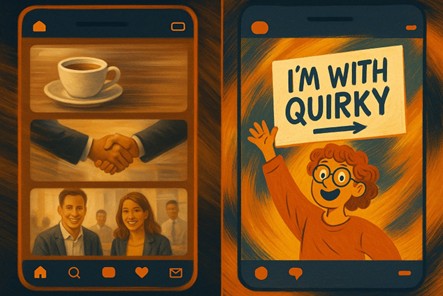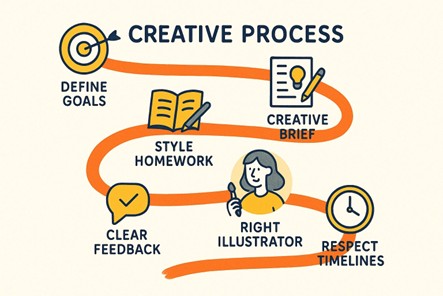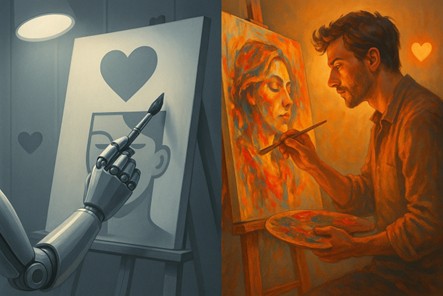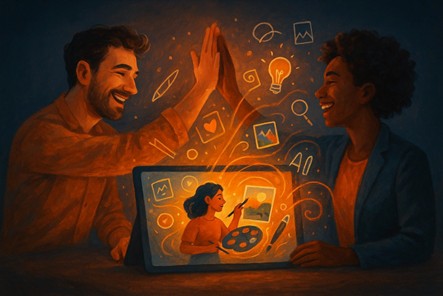Why does everyone want custom illustrations, but few get them right?
Imagine you are scrolling through Instagram and every post looks the same, you know, those bright photos of coffee cups, corporate handshakes, and people with a smile pointing at their laptops. It’s all so painfully generic that you can’t remember who posted what five minutes later. Then suddenly, one post stops you cold. It’s a unique, colorful sketch of a character holding a sign with a clever tagline. It’s fun, it’s bold, and most importantly, it feels different. You actually remember the brand behind it. That, right there, is custom illustration.
In today’s world, where all the war is about grabbing someone’s attention, illustration is your key to get noticed, remembered, and talked about. Studies show that people remember 80% of what they see , compared to only 20% of what they read. And in a digital landscape where everyone is fighting for a scroll-stopping moment, custom artwork can do what generic photos and templated graphics never will i.e., make your brand stand out.

But here’s the thing. While almost every business, marketer, and creator wants that “wow” effect that illustrations can deliver, most don’t actually get it right. They hire an illustrator or commission artwork, only to end up disappointed with the results.
But why does this happen? It’s not because illustrators lack talent. And it’s not because businesses don’t care about visuals (they know they need them). The problem lies somewhere in between, in the messy middle ground where expectations collide with execution.
And that’s what this blog is all about. We’re going to discuss the #1 problem people face with custom illustration, the one challenge that derails projects, wastes money, and frustrates everyone involved. More importantly, we’ll show you exactly how to fix it. You’ll see why the issue is so common, why it matters more than you think.
Let’s clear the air. When people hear the term “custom illustration,” they often imagine someone doodling on a tablet and calling it a day. Sounds simple, right? But here’s the truth: Custom illustration is so much more than just drawing pretty pictures. It’s about turning a brand’s voice, values, and personality into a visual language that people instantly connect with.
At its core, custom illustration is art designed specifically for a purpose and a story. Unlike stock images or generic templates, it’s created to reflect your brand, your USP, your audience, and your unique vibe.
So, what does that look like in the real world? Here are a few common uses:
And it doesn’t stop there. With today’s tools, custom illustration combines traditional art, giving brands limitless ways to express themselves. And it’s not just about looking good, but it’s more about strategy. A good illustrator doesn’t just ask, “What should I draw?” They ask, “What do you want people to feel? Who are we speaking to? How do we want them to remember this?” That’s why illustrations work; they tell stories that bypass logic and hit emotions straight on.
But wait! If custom illustration is so powerful, why do so many people walk away unhappy with the results? Well, that brings us to the part most people don’t like to talk about, the #1 problem of almost every illustration project.
Here it is, the truth bomb! The biggest problem people face with custom illustration isn’t the cost. It isn’t whether they chose the “right” illustrator. It isn’t even deadlines.
It’s miscommunication!!
More specifically, vague or unclear project briefs leave illustrators guessing and clients disappointed.
Think about it, when you order custom work, you’re essentially asking an artist to step inside your head and bring your vision to life. The problem is, most people don’t actually know how to explain what’s in their head. They’ll say things like, “I want something fun but professional. Make it pop.” Which, let’s be honest, could mean a thousand different things depending on who you ask.

This, however, results in the illustrator delivering something they think matches “fun but professional,” but to the client, it feels off. Cue the awkward emails, rounds of revisions, and a sense of frustration on both sides. What was supposed to be an exciting, creative collaboration turns into a slow train wreck.
And here’s where it snowballs. A vague brief doesn’t just cause style mismatches; it also creates a chain reaction of custom art process challenges:
Sound familiar? That’s because this happens a lot. According to many design agencies, unclear project direction is the top reason creative projects stall or fail. And it’s usually not about lack of talent or effort. It’s about both parties speaking different “languages.”
Still didn’t get it? Let’s understand it through an example. Suppose you walked into a barber shop and said, “Give me a haircut that feels modern.” Now, what do you think are the chances that you will walk out with exactly what you pictured? Pretty narrow, right? But if you bring in a photo reference and explain what you like about it, the barber instantly knows what you want.
Illustration works the same way!
Now, you might be thinking, but shouldn’t professional illustrators just know what I want? Nope. Even the most talented illustrator isn’t a mind reader. They rely on your brief to guide their creativity. Without clarity, they’re basically drawing blindfolded.
This is why so many businesses feel let down by their first custom illustration project. They expected magic, but forgot that magic still needs direction.
So, the problem isn’t that the custom illustration doesn’t work. It’s that most people don’t know how to set it up for success. Fix that, and suddenly the entire game changes.
Okay, so miscommunication sounds like a pretty “basic” issue, right? Almost harmless, like a mild inconvenience you can shrug off. Wrong!! In the world of custom illustration, unclear direction isn’t just a small hiccup. It’s the domino effect that knocks everything else down. And when it falls, the results are frustrating, expensive, time-consuming, and sometimes brand-damaging.
Let’s break down exactly why this one problem matters more than people realize.
When a project goes off the rails because the brief was vague, everything slows down. What was supposed to be one or two revisions turns into five or six. That’s weeks of back-and-forth emails, endless file attachments, and mounting costs. For businesses on a deadline, say, a book launch or a product rebrand, this delay can mean missing critical opportunities.
And soon, even if the project eventually gets done, you’ve spent double the time and double the money compared to what you would’ve with a clear brief.
Imagine putting energy into a campaign only to end up with visuals that don’t capture your message. That results in a campaign that fails. This is one of the most common issues with custom artwork; it doesn’t “speak” to the audience because it was created with misaligned expectations.
Take, for example, a company that wants to appeal to Gen Z but accidentally creates illustrations that feel like they belong in a 1990s business manual. The mismatch is evident, and instead of attracting their target audience, the brand looks out of touch. That’s a problem you can’t just fix with a social media caption.
Illustration should be a creative partnership, but unclear communication turns it into a blame game. Clients feel like illustrators don’t listen. Illustrators feel like clients can’t make up their minds. Tension builds, and what should’ve been an inspiring collaboration becomes an exhausting tug-of-war.
This is why so many first-time clients shy away from illustration after one bad experience. They walk away thinking, “Maybe custom illustration just isn’t worth it.” But the truth is, the medium itself isn’t the problem; the process is.
Here’s where it gets really serious. Every visual you put out into the world is a representation of your brand. If your illustration is unclear, confusing, or inconsistent with your message, it weakens your brand identity.
Think about how powerful consistent visuals are. Nike’s swoosh, Mailchimp’s monkey, Duolingo’s green owl, all these are storytelling tools. Now imagine if Nike’s swoosh kept changing shape or color because of miscommunication between teams. It wouldn’t be the same powerful symbol it is today.
Thus, the bottom line is that miscommunication in illustration isn’t a “soft” problem. It’s a hard, measurable one with real consequences. However, the good news is that this problem has a fix, a fix that turns messy and chaotic projects into smooth and collaborative successes.
And that’s exactly what we’ll discuss next.
Alright, enough doom and gloom, let’s talk solutions. The truth is, fixing the #1 problem with custom illustration isn’t rocket science. It doesn’t require insider jargon, endless meetings, or psychic powers. It comes down to building a clear and collaborative process from the start. Here’s how you can nail it every time.
Before you even think about colors or drawing styles, ask yourself: What story do I want this illustration to tell?

Without a clear “why,” you’ll never get the right “what.” Defining goals gives your illustrator a direction to work with.
Honestly, words are notoriously bad at describing visuals. If you say “playful,” your illustrator might picture cartoon artworks, while you’re imagining colorful abstract shapes. To bridge the gap, collect reference images.
Mood boards, Pinterest collections, screenshots of things you love (and even things you don’t), these can help you greatly.
A well-described brief is the ultimate tool for avoiding miscommunication. When learning how to brief an illustrator, keep these must-haves in mind:
This part is often overlooked. Just because someone is a great artist doesn’t mean they’re the right fit for your project. Hiring an illustrator is about matching style and skill to your brand’s needs.
For example, if you need watercolors for a children’s book, don’t hire someone whose portfolio is filled with bold comic-book art. That’s not a skill mismatch, it’s a style mismatch. Check portfolios, ask about experience in your niche, and don’t just go with the cheapest option.
Remember, illustrators aren’t mind readers. Feedback like “Make it pop” or “I don’t love it” is useless. Instead, be more specific. Do you want brighter colors? A softer line style? A bolder font on the poster it’s paired with?
Here’s a tip! When possible, use visuals in your feedback. Circle parts of a sketch, drop reference images, or show examples.
This one’s simple but often ignored. Custom illustration isn’t just “drawing.” It’s research, brainstorming, sketching, revisions, and final execution. All of that takes time and expertise.
If you’re hiring an illustrator for a project due next week, don’t expect masterpiece-level work without breathing room. And if you’re on a short budget, be upfront so you can align expectations. Respecting the timeline and budget keeps everyone happy and avoids resentment down the line.
By now you’ve probably seen it. AI art is flooding social media feeds, people typing a few words into a generator, and out pops a “painting” or “comic strip” in seconds. It’s fast, it’s showy, and it raises an obvious question: If AI can make art instantly, why bother with custom illustration?
It’s a fair question. But here’s the thing! While AI tools are impressive and, honestly, kind of fun to play with, they’re not a replacement for the real thing. At least, not if you care about quality, strategy, and originality.
Remember our #1 problem? Miscommunication. AI doesn’t fix that. It makes it worse. If a human illustrator struggles when you say, “Make it fun but professional,” imagine how an algorithm interprets that. You might get something visually striking, but it’s usually generic, inconsistent, or flat-out wrong for your brand.
Custom illustration works because it’s not just about visuals. But it’s more about context. An illustrator asks questions, digs into your goals, and translates your ideas into something meaningful. Whereas AI just mashes patterns together based on data.

One of the most overlooked issues with AI art is ownership. Since AI pulls from massive datasets (including copyrighted images), there’s a very real risk that what it spits out looks suspiciously similar to someone else’s work. That’s a legal headache waiting to happen.
With Custom illustration services , you don’t just get a pretty picture. You get satisfaction and assurance that your artwork is original, created for you, and comes with clear usage rights. That’s a sense of security AI can’t offer.
At the end of the day, illustration is storytelling. It’s about capturing a mood, an emotion, or a personality that connects with real people. And while AI can create something that looks like art, it doesn’t feel like it has a soul.
Illustrators fill their work with subtle human touches, you know, a sense of humor, a cultural reference, an intentional imperfection, that makes the piece relatable. AI art, no matter how smooth, often feels sterile.
So, where does that leave us?
AI might be a fun tool for experimenting or brainstorming, but when it comes to building a recognizable, trustworthy brand, you need humans. You need illustrators who understand strategy, who can translate vague ideas into powerful visuals, and who can make sure your brand feels like something people want to remember.
So, we have tackled the big problem of custom illustration, i.e., miscommunication. But like any good story, there are always sidekicks of the villain. These aren’t quite as catastrophic as a full-blown, unclear brief, but they’re the sneaky little hurdles that can still derail your project if you’re not careful. Let’s shine a light on them and, more importantly, see how to avoid them.
We live in the age of two-day shipping and AI tools that generate artwork in seconds. So, when people go for custom illustrations, they sometimes expect results yesterday. But custom artwork requires time. It is deliberate, thoughtful, and worth the wait.
Mini-Fix: Build realistic timelines. Ask your illustrator upfront how long sketches, drafts, and finals will take. Include in revisions. Rushing the process won’t give you brilliance. It’ll just give you burnout (for both sides).
Some clients ask an illustrator to “design my brochure,” or expect a designer to “hand-draw a symbol.” While both roles sound similar, they’re not identical. Illustration is about creating unique imagery, while graphic design is about arranging visual elements (like text, photos, and illustrations) into a functional layout.
Mini-Fix: Know who you need. If you need a custom drawing, hire an illustrator. If you need layouts and typography, hire a designer. If you need both, find a team or an illustration design agency that covers both bases.
A client requests revision after revision, not because the work is “wrong,” but because they’re not sure what they want. Suddenly, what was supposed to be a three-draft project turns into revision infinity.
Mini-Fix: Agree on a revision limit in your contract. Three rounds are standard. If you still can’t decide after that, it’s not the illustrator; it’s your vision that needs clarity.
Many clients assume that if they pay for an illustration, they automatically own it outright. Not always true. Ownership depends on the agreement. Some projects grant full rights, while others cover limited usage. Overlooking this can land you in sticky territory down the road.
Mini-Fix: Discuss rights at the start. Be clear about where you’ll use the illustration, for example, packaging, online ads, and merch, and make sure it’s reflected in the agreement.
Sometimes clients underestimate what quality illustration costs. They assume it’s the same as downloading a stock image. But that’s not true. You are paying for skill, creativity, and originality.
Mini-Fix: Do your research on pricing ranges before starting. If the budget is tight, be upfront. Many illustrators can adjust scope without compromising professionalism.
We’ve covered a lot of ground, and if there’s one thing to take away, it’s this: the #1 problem people face with custom illustration isn’t talent, or budget, or even timing. It’s miscommunication.
That’s it. The single biggest reason projects fall flat is that clients and illustrators aren’t speaking the same language at the start. A vague brief leads to mismatched styles, wasted time, ballooning budgets, and frustrated relationships. And yet, the fix is refreshingly simple, to bring clarity.
And yes, there will always be challenges. You’ll still have to manage expectations, respect creative expertise, and occasionally wrestle with issues with custom artwork and deadlines. But those challenges are worth it. They’re the price of admission for something that stock photos, generic templates, or even AI tools can’t deliver.

So, if you’ve ever been burned by a disappointing project, don’t write off illustration altogether. Instead, write a better brief. Build a better process. And most importantly, find a partner who knows how to turn your brand’s vision into art that resonates.
That’s where working with professionals like us makes all the difference. Our experienced custom illustration services team will guide you through the process, ask the right questions, and make sure your visuals are aligned with your goals from start to finish.
So go ahead and reach out to us! Nail your custom illustration project. And watch as your brand story comes alive in ways you never thought possible.
Looking for more information? Call us at +1 (855) 521-5040 for quick support!






Have a project in mind? Reach out to us, and we’ll help turn your ideas into stunning illustrations.
Tell us what you need, and we’ll create a custom illustration just for you. Reach out today and let's get started!

Copyright © 2025 360 Illustration House | All rights reserved. Terms And Conditions | Privacy Policy | Refund Policy
